2015 October 30
A Halloween Asteroid

Historically-speaking, we know of more than 300 near-Earth asteroids that have passed closer to the Earth than this one, but of these ‘TB145’ is the SECOND largest to do so after 2004 XP14 which came by in 2006. We shall have to wait until 2027 August 7 for the next known object (1999 AN10) that is larger than this one to come closer to the Earth. Then, like London buses, we have two more passing by in quick succession: 2001 WN5 in 2028 followed by the much heralded (99942) Apophis in 2029. However, unlike these later three, ‘TB145’ is following a comet-like orbit, rather like that of Comet 2P/Encke but more tilted to the plane of the Solar System. Is it a dormant or extinct comet?
For UK observers the best views will be on the night of Friday, October 30/31 when it will attain 11th magnitude and be located between the 
Observers will need to look up an ephemeris of its positions for a location near them to avoid parallax effects. I suggest using the Minor Planet Ephemeris Service at: http://www.minorplanetcenter.net/iau/MPEph/MPEph.html and, if you are in the UK, using the Observatory Code ‘456’ to get a sufficiently accurate topocentric ephemeris.
Currently, the weather forecast in the UK looks to be rather cloudy, although clear skies should arrive in southern England during the early hours of Saturday morning. If you miss out seeing it, not to worry – NASA and the Jet Propulsion Laboratory have scheduled radar observations using Goldstone/Green Bank/Arecibo and these should reveal the nature of this approximately 400-metre size object in unprecedented detail with a resolution of ~2 metres.
Richard Miles
BAA Asteroids and Remote Planets Section
